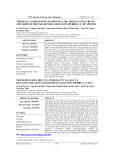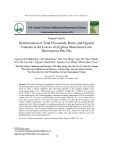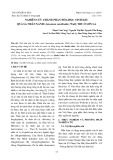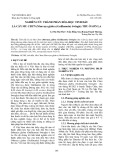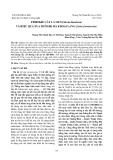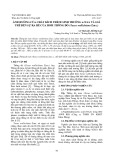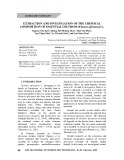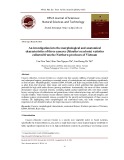
JOURNAL OF SCIENCE AND TECHNOLOGY DONG NAI TECHNOLOGY UNIVERSITY
346
Special Issue
PREPARATION OF MEDICAL SHAMPOO FROM POMELO (Citrus
grandis L.) PEELS, LIME (Citrus aurantiifolia) PEELS, AND
FABACEAE (Fructus Gleditsiae) FRUIT
Nguyen Hong Anh, Nguyen Thi Thuy Duyen, Ho Thi Ngoc Nhung, Hoang Thi My Le, Huynh
Thi Thuy Loan, Lai Thi Hien*
1Dong Nai Technology University
*Corresponding author: Lai Thi Hien, laithihien@dntu.edu.vn
GENERAL INFORMATION
ABSTRACT
Received date: 07/03/2024
Shampoo is a necessary hair care item for every person's
everyday routine. The quest for environmentally friendly and
naturally sourced products has led to an investigation into the
production of synthetic shampoos using natural components
such as fabaceae fruit, pomelo peel, and lime peel. In this
study, we investigated the effects of pomelo peel, fabaceae
fruit, and lime peel in the ratios 1:1:1, 1:2:1, 2:1:1, and 1:1:2.
Analyze the extract percentages of fabaceae, pomelo, and
lime (40, 60, and 80%). Examine the effects of glucose D
MGT thickener (5%, 10%, 15%, and 20%) on shampoo
qualities in compliance with TCVN 6972:2001 criteria.
Consequently, the shampoo formula selects a 1:2:1 ratio with
the extract of the raw material. In order for the shampoo to
satisfy the requirements for assessing shampoo qualities, it
contains 60% extract and 15% glucose D MGT.
Revised date: 21/05/2024
Accepted date: 24/07/2024
KEYWORD
Shampoo,
Pomelo peel,
Lime peel,
Fabaceae fruit
1. INTRODUCTION
In order to satisfy demands for beauty and
care while enhancing consumer safety,
individuals these days frequently utilize
components with a natural origin. To increase
the efficacy of these goods and assist
consumers in selecting and using them
appropriately, a full analysis of their formula,
purpose, and usage is necessary. Customers
also like medicated shampoo solutions since
they nourish healthy hair without harming the
scalp. Fabaceae fruit has been used by women
as a hair shampoo since ancient times.
Fabaceae fruit is high in fatty acids, saponin,
and vitamin E, which nourish, soften, and
moisturize hair while protecting it from UV
radiation and environmental factors (Dimitar
G. Bojilov et al., 2013). Pomelo peel is rich in
phytonutrients, vitamin C, and antioxidants
(Shahnawaz Ahmed et al., 2019). These
ingredients have the power to balance natural
oils, cleanse the hair and scalp, and aid in the
prevention of dandruff. Antioxidants and
vitamin C are abundant in lime peel (Somayeh
Sadat Fakoor Janati et al, 2012). These
ingredients have antimicrobial properties,
balance natural oils on the scalp, and aid in
deep cleaning. Additionally, thickeners are
needed in products like shower gel and
shampoo to make them easier to use and
maintain the homogeneity of the other

347
JOURNAL OF SCIENCE AND TECHNOLOGY DONG NAI TECHNOLOGY UNIVERSITY
Special Issue
ingredients. PEG-120 Methyl Glucose
Dioleate, scientifically known as DOE 120 or
glucose D MGT thickener, has water
(29.99%), tocopherol (0.01%), and methyl
glucose triisostearate (70%) as its constituent
ingredients. The cosmetics industry makes
extensive use of this plant-based raw material
(Charoenchai, et al., 2020;
Jongrungruangchok, et al., 2020). This is a
surfactant that is made of ethylene glycol and
glucose. It reacts with oxidation processes to
form a material with plastic qualities. Because
of its propensity to foam, soothe, and
moisturize the skin, this material is frequently
used in washing and skin care products, such
as lotions, shower gels, and facial cleansers.
Furthermore, we investigated the impact of
the glucose thickener D MGT % on the
shampoo's quality in order to determine the
ideal ratio for producing a natural shampoo
that deters dandruff, nourishes hair, and is safe
for the environment.
2. METHODS
2.1. Subjects of research
Ingredients from Thai Son Pharmaceutical
Company include fabaceae (Fructus
Gleditsiae) fruit, limes (Citrus aurantiifolia),
and pomelo (Citrus grandis L.).
Chemicals supplied by Organic Company
include glucose D, dimethicone, DMDM
Hydantoin, and vitamin B5. Vietnam's NaCl
and China's Citric Acid were supplied by
Trung Son Technology Co., Ltd.
2.2. The process involves extracting a
mixture of lime peel, pomelo peel, and
fabaceae fruit ingredients.
Weigh 50g each of pomelo peel, fabaceae
fruit, and lime peel accurately into a 1000ml
flask. Extract using the reflux method at 80 °C
for 60 minutes, using a drug-to-solvent ratio of
1:10 and water as the extraction solvent. We
blended each extract from the first and second.
2.3. Shampoo preparation process
With reference to a few documents
(Jaganadathan, 2009; Tomasin, 2011; Hati
Deepak, 2010), the group suggested a recipe for
making shampoo that would include extracts
from lime and pomelo, as shown in table 1.
The following processes are followed in
order to prepare the shampoo. To make a
homogenous solution, first dissolve the
glucose D MGT and NaCl in the extract over
low heat on the stove (1). To achieve a
homogenous solution, first dissolve vitamin
B5 completely in distilled water. Then, add
citric acid and dimethicone and stir vigorously
at a speed of 300 rpm to obtain a transparent
solution (2). Third, combine (1) and (2), then
use a magnetic stirrer set to 300 rpm for 10
minutes to fully mix the mixture. Add the
DMDM hydantoin and stir well. Lastly, fill the
bottle with the product and screw on the cap.
Table 1. Shampoo formulation with fabaceae fruit,
lime peel, and pomelo peel
Material
Role
Ratio(%
w/w)
Glucose D
MGT
Surfactant
Change
Extract of
Pomelo, Lime
and fabaceae
fruit
Solvent
Change
Sodium
chloride (NaCl)
Thickener
6
Citric acid
(C6H8O7)
pH regulator
4
Vitamin B5
moisturizer and a
solvent for essential
oil dissolution
6
Dimethicone
Shine and smoothes
hair
8.5
DMDM
Hydantoin
Preservative
0.5

JOURNAL OF SCIENCE AND TECHNOLOGY DONG NAI TECHNOLOGY UNIVERSITY
348
Special Issue
2.4. Survey the variables influencing the
quality of shampoo.
We looked into the component ratio:
Pomelo peel Fabaceae fruit: Lime peel (1:1:1,
1:2:1, 2:1:1, 1:1:2); Examine the impact of
applying shampoo containing varying extract
ratios (40%, 60%, and 80%); Examine the
effects of thickeners with 5%, 10%, 15%, or
20% glucose D MGT content. Sensory criteria,
foaming and foam stability, filth dispersion
ability, and wetting time are among the
monitoring criteria that are constructed in
accordance with the general standards of
shampoos (TCVN 6972:2001) and study by
(Azadbakht M. et al., 2018). The following are
the specific ways that each indicator is being
monitored.
Through the shampoo's clarity, color, and
aroma, sensory factors are assessed. We used a
Hanna pH meter to determine pH at ambient
temperature.
We measured the foaming ability and foam
stability by adding about 5 ml of shampoo
solution and 50 ml of distilled water to a 250
ml measuring tube. Cover the tube tightly with
paraffin film and shake it rapidly ten times.
Next, note the amount of foam produced at the
first 0 minute mark and the 5 minute mark
after shaking. Finally, apply the following
formula to determine the foaming ability and
foam stability:
(1)
In which:
V0 is the foam volume at 0 minutes (ml).
V1 is the foam volume at 5 minutes (ml).
We determined the ability to disperse dirt
by transferring 50 ml of shampoo solution into
a 250 ml measuring cylinder, adding a drop of
ink, covering it with sturdy paraffin film, and
shaking quickly 10 times. Observe the color of
the foam that develops. We categorize the
amount of ink in the foam into four groups:
none, little, medium, and much. The shampoo
is deemed to be of low grade if there is a
noticeable concentration of ink in the foam. If
the foam contains dirt, it will stick to the hair
and make cleaning impossible. To be able to
clean, the dirt needs to be in the water.
To determine the wetting time, prepare a
25 mm-diameter circular piece of cloth. Gently
drop 50 cc of shampoo solution onto the
cloth's surface. Timing the start of the
solution's drop until the cloth begins to get
completely wet determines the soaking time.
Weigh precisely about 4 g of shampoo into
a clean, dry petri dish to determine the solids
ratio. Then dry at 70 °C for 6 hours to let the
liquid in the shampoo evaporate. After drying,
re-weigh the shampoo disc. The following
formula determines the percentage of solids:
(2)
In which:
T: the percentage of solids (%).
M1: Disc mass of shampoo before drying
(g).
M2: The mass of the shampoo disc in
grams following drying.
m: the shampoo's initial volume (g).
Three runs of the tests were conducted.
We use Excel to process the experimental data,
and Minitab is used to evaluate the anova one
factor at the 95% significant level.
3. FINDINGS AND DISCUSSION
3.1. Results of the survey of the appropriate
raw material ratio
Table 2. Displays the results of the
ingredient ratio of Pomelo peel: fabaceae fruit:
lime peel (1:1:1, 1:2:1, 2:1:1, 1:1:2).

349
JOURNAL OF SCIENCE AND TECHNOLOGY DONG NAI TECHNOLOGY UNIVERSITY
Special Issue
Table 2. Raw Material Ratio Survey Results
Raw material
ratio
Sensory
Foaming ability
pH
1:1:1
samples 1
Light brown, clear, lightly fragrant
48ml
After 5 minutes: 37.5ml
6.3
1:2:1
samples 2
Brown, clear, fragrant of Pomelo and
Lime
52ml
After 5 minutes: 50ml
6.4
2:1:1
samples 3
Light brown color, lightly fragrant
48ml
After 5 minutes: 31ml
6.5
1:1:2
samples 4
Dark brown color, lightly fragrant with
fabaceae scent
50ml
After 5 minutes: 50ml
6.1
Current trends encourage users of herbal
shampoos. Typically, people use
alkanolamides to create stable foams, but they
can also cause cancer because they produce
nitrosamines. Natural items are starting to
emerge as a new category in home goods. To
substitute materials, use the saponins found in
herbs such as lime peel, fabaceae fruit, and
pomelo peel. As surfactants and emulsifiers,
saponins are employed (Dinh Nhat Do et al.,
2019).
Research has shown that the pH of herbal
shampoos affects hair quality, reduces ocular
discomfort, and maintains the scalp's natural
equilibrium. Mild acidity, which also helps to
tighten flakes and reduce puffiness, produces
shine. As can be observed from the table
below, all shampoos have an acid balance that
is close to skin pH, ranging from 6.1 to 6.4
(Dhayanithi S.et al., 2021).
Samples 1, 3, and 4 all have a slight aroma,
but not enough to meet the standards based on
sensory ratings. Sample 2 has a combined
scent of pomelo and lime. In this sense,
samples 1 and 3 are less able to form foam
than samples 2 and 4. The samples' pH is
within acceptable limits and does not harm the
scalp. We chose Sample 2 (ratio 1:2:1) as the
raw material ratio for the extract because it
best meets the evaluation criteria of pH,
foaming ability, and sensory aspects.
3.2. Findings regarding the impact of the
raw material mixture extract%
Table 3. Results of the survey on extraction ratios
%
extract
40%
60%
80%
Sensory
Light brown
color, mild
aroma, thick
consistency
Brown,
fragrant,
paste form
Brown,
fragrant,
liquid
pH
6.0±0.3a
6.4±0.2a
6.2±0.3a
Foaming
ability
75ml
After 5
minutes:
67.5ml
80ml
After 5
minutes:
78ml
75ml
After 5
minutes:
60ml
Capacity
to
disperse
dirt
None
None
Medium
Wetting
time
(seconds)
270±5.5a
205±7.5b
180±3.7c
Solid
Percentag
e (%)
47.5±0.3a
22.5375±1
.1b
20.25±0.5c

JOURNAL OF SCIENCE AND TECHNOLOGY DONG NAI TECHNOLOGY UNIVERSITY
350
Special Issue
Table 4. Findings from an analysis of the impact of adding glucose-D MGT thickener to shampoo
formulation
% Glucose D
MGT
5%
10%
15%
20%
Sensory
Brown, fragrant,
liquid
Brown, fragrant,
liquid
Brown, fragrant,
paste form
Light brown color,
mild aroma, thick
consistency
pH
6.0±0.3a
6.1±0.6a
6.3±0.2a
6.2±0.1a
Foaming ability
118ml
After 5 minutes:
104ml
110ml
After 5 minutes:
95ml
104ml
After 5 minutes:
100ml
83ml
After 5 minutes:
79ml
Capacity to
disperse dirt
None
None
None
Medium
Wetting time
(seconds)
170±13a
180±10b
205±9c
234±11d
Solid Percentage
(%)
20.25±0.5a
21.65±0.5b
22.54±1.1c
37.5±1.7d
Table 3's findings demonstrate that all
three samples' pH levels are acceptable.
However, 80% of the extract sample failed the
test that measured its ability to disperse dirt,
while 40% of the extract sample failed the test
that measured the amount of solids in the
sample and the wetting time. Quality
shampoos usually comprise solid components
ranging from 20% to 35%. A low solids
content will make the product watery and
rapidly wash off, whereas a high solids content
will make it difficult to work on the hair or
wash out (Malpani T. et al., 2020). The
surfactant's concentration determines how well
it wets (Manikar and Jolly, 2000). An
excessively extended wetting period will make
the user uncomfortable. One crucial factor in
assessing a shampoo's cleansing efficacy is its
capacity to disperse dirt. Shampoo cannot
remove dirt if it concentrates ink in the foam,
according to tests on this function (Ali and
Kadhim, 2011). Therefore, shampoo is most
likely to work when the water phase contains
all of the toner and the foam is colorless.
Customers place a high value on foaming
ability. Low foam makes the shampoo seem
like it's not cleaning the hair well, and high
foam makes it take a long time to wash.
Therefore, it is considered a vital component
in the evaluation of shampoos. When test
samples are available in about the same
amount of foam volume in five minutes, it
means that there is good foam stability. The
combination of soap nuts, sheekakai, and
ziziphus may be the cause of the shampoo's
higher foaming qualities (Sarath et al., 2013).
Consequently, a 60% extract sample is
appropriate.
3.3. The survey results determine the ratio
of thickener, specifically glucose D-MGT, in
shampoo
A very efficient and user-friendly
polyether thickener, glucose-MGT works with
many kinds of surfactants, including cationic,
anionic, non-ionic, and amphoteric ones. Skin
and eyes can be safely exposed to it. There is
no need for heating (J. Kleinen et al.,


